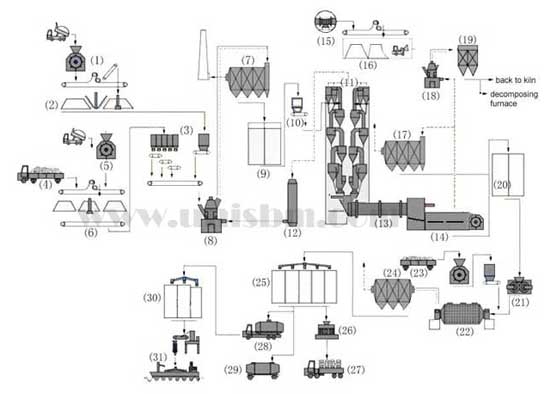Concrete making process flow

- 1) Limestone crusher
- 2) Limestone prehomogenizing yard
- 3) Batch calculation
- 4) Additive
- 5) Crusher
- 6) Additive yard
- 7) Dust collection
- 8) Raw mill
- 9) Homogenization silo
- 10) Feeding calculation
- 11) preheater
- 12) Humidifier tower
- 13) Rotary kiln
- 14) Cooler
- 15) Raw coal
- 16) Coal yard
- 17) Electric precipitator
- 18) Coal mill
- 19) Burgy precipitator
- 20) Clinker silo
- 21) High pressure grinding roll
- 22) Ball mill
- 23) Gypsum
- 24) Concrete precipitator
- 25) Concrete storage
- 26) Packer
- 27) car stowage
- 28) car loader
- 29) train stowage
- 30) port silo
- 31) bulk concrete
1. Crushing and Pre-homogenization.
(1) Concrete Crushing.
During producing Concrete, most of the raw materials must be first crushed before being used to make concrete. Among these raw materials which include lime stone, clay, iron ore and coal, etc. the lime stone is of the greatest usage to make concrete. With comparatively larger particles and higher hardness, crushing the lime stone to required fineness after mining is of relatively important consequence among crushing all those raw materials. There are many crushers used in crushing these raw materials, such as jaw crusher, impact crusher, one crusher and vertical shaft impact crusher, etc. According to the raw materials' different particles and hardness, there are several suitable crushers which can be used in the crushing.
(2) Pre-homogenization of raw materials.
Pre-equalization technology is to use the scientific stacker reclaimer technology to realize the initial homogenization of raw materials, so that raw materials yard has the functions of storage and homogenization at the same time during the process of the retention of raw materials.
2. Raw Material Preparation.
It takes at least 3 ton materials (including raw stuff, fuel, clinker, compound and gypsum) to produce 1 ton Portland concrete during the production. According to figures, the traditional type dry process concrete of clinker consumes more than 60% energy of the whole factory. So the choice of grinding machines is very important.
3. Raw material Homogenization.
In the process of new dry concrete production, the stability of pit entry clinker raw material component is the premise of the whole system. Raw material homogenization system plays very important role in the stability of pit entry clinker raw material component.
4. pre-heater and calciner.
Preheating the raw materials and decomposing partly in pre-heater, which reduce the works of rotary kiln, can shorten the length of rotary kiln. After a series of physical process in the shorter rotary kiln, the energy consumption of this system improve the efficiency and reduce consumption.
(1) dispersing materials.
80% heat transfer process happens in the entrance pipeline. The raw materials fed in pre-heater, meeting the high speed updraft, move up with the airflow and get dispersed.
(2) Gas-Solids Separation.
When the airflow enters into cyclone muff with powder, it has to spiral and move down meanwhile. Finally, it arrives to the end of the cone then upwards and discharges from vent pipe.
(3) Predecomposition.
The appearance of predecomposition is a leap of concrete burning technology. This process is featured with quality, efficiency and low consumption, etc.
5. The burning of concrete clinker.
Raw materials will be preheating and pre-decomposition in the cyclone preheater and then carried out into the rotary kiln for clinker burning. After the clinker burning, the temperature starts to fall. Finally with the concrete clinker cooler, the temperature of high-temperature clinker discharged from the rotary kiln will be cooled to the temperature which is suitable to downstream transport, store, and concrete. At the same time, the sensible heat of high-temperature clinker will be recycled, which improves the thermal efficiency and clinker quality of the system.
6. Concrete Grinding.
Grinding is the last process of concrete produce and also is the most current consuming working procedure. Concrete clinker get grinded into the right size. The smaller the particle size is, the better the final concrete is. There are many grinding machines suitable to grind the concrete clinker, such as ball mill, vertical mill, high pressure suspension grinding machine and Raymond mill, etc. We will choose suitable grinding machine for you according to your requirements. With reliable quality and Certification authority, you can trust us.
7. Concrete Packaging.
What you should pay attention to after producing concrete is concrete packaging. It's important to intact the chemical and physical properties of the concrete for a longer period of time.
Concrete Production
Concrete is pulverized with the mixture of limestone, clay, and iron ore powder in proportion. At this time the mixture is called raw materials. Followed by calcination, the general temperature is of 1450 degrees. After calcination, the product is called clinker. Then according to a certain percentage, the clinker is mixed with gypsum. The mixture is then grinded to the required fineness. Here you have produced concrete. This is only a general description. Here you can learn about the whole process in detail.
- » Stone Crushing Plant
- » Sand Making Plant
- » Coal Crushing Plant
- » Concrete Production Line
- » Cement Plant
- » Ore Processing
- » Construction Waste Recycling
- » Gold Mining Equipment
- » Aggregate Crushing Plant
- » Ballast Crushing & Screening Plant
- » Stone Grinding
- » Mining equipment
- » Stone quarry plant
- - Tel:0086-21-58386189
- - Fax:0086-21-58383058
- - Email:

